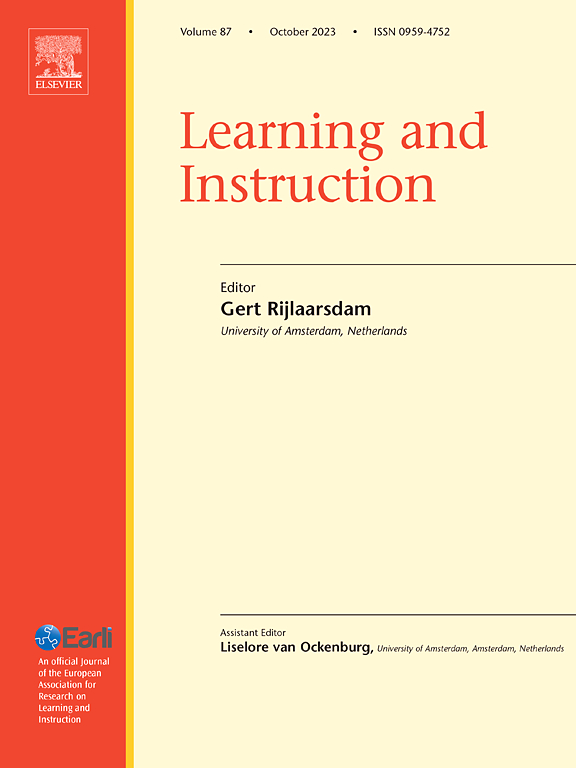视频交流中的自我观对群体头脑风暴的影响
IF 4.9
1区 教育学
Q1 EDUCATION & EDUCATIONAL RESEARCH
引用次数: 0
摘要
小组头脑风暴是促进学生创造性思维的有力策略。随着在线协作学习的兴起,通过视频交流进行的集体头脑风暴变得越来越普遍。然而,视频交流不同于面对面的交流,尤其是它提供了一个自我观察的功能。目的研究视频交流中的自我视角窗口对群体头脑风暴表现及相关社会认知过程的影响,以及社交焦虑的调节作用。实验1:N = 168;实验2:招募140名受试者,随机成对进行实验。方法采用“备选使用任务”方法,评估在视频交流情境下,自我视图开启或关闭对小组头脑风暴表现的影响。实验1测量了小组成员在头脑风暴任务中的皮电活动和互动体验,作为社会过程的指标。实验2测量了注意力分配,作为认知过程的指标。此外,本实验还评估了各组的社交焦虑水平,以分析其调节作用。结果实验1显示,自我观组的想法产生更灵活,皮肤电导反应更高,互动体验更好。实验2发现自我观影响个体的注意分配,群体社交焦虑水平调节自我观对思想流畅性的促进作用。结论自我观仅在社交焦虑低的群体中提高了群体头脑风暴的灵活性和流畅性。它增强了社会过程中的觉醒和互动体验,影响了认知过程中的注意分配。本文章由计算机程序翻译,如有差异,请以英文原文为准。
Impact of self-view in video communication on group brainstorming
Background
Group brainstorming is a powerful strategy to boost students’ creative thinking. With the surge in online collaborative learning, group brainstorming via video communication is becoming increasingly common. However, video communication differs from face-to-face interactions, notably by offering a self-view feature.
Aims
This study examines how self-view window in video communication influences group brainstorming performance and related social and cognitive processes, as well as the moderating role of social anxiety.
Samples
Participants (Experiment 1: N = 168; Experiment 2: N = 140) were recruited and randomly paired into dyads for the experiments.
Methods
The Alternative Uses Tasks were used to assess differences in the group brainstorming performance in video communication contexts with the self-view enabled or disabled. Experiment 1 measured the electrodermal activity and interaction experience of group members during the brainstorming task, serving as indicators of social processes. Experiment 2 measured attention distribution, serving as indicators of cognitive processes. Furthermore, this experiment assessed the social anxiety levels among the groups to analyze its moderating effects.
Results
Experiment 1 revealed that groups in the self-view condition generated ideas with greater flexibility, accompanied by higher skin conductance responses and better interactive experience. Experiment 2 found that self-view influenced individuals’ attention distribution, and that group social anxiety level moderated the facilitating effect of self-view on idea fluency.
Conclusions
Self-view improves group brainstorming flexibility and increases fluency only in groups with low social anxiety. It heightens arousal and the interaction experience during the social process, influencing attention distribution in the cognitive process.
求助全文
通过发布文献求助,成功后即可免费获取论文全文。
去求助
来源期刊

Learning and Instruction
Multiple-
CiteScore
11.30
自引率
4.80%
发文量
109
期刊介绍:
As an international, multi-disciplinary, peer-refereed journal, Learning and Instruction provides a platform for the publication of the most advanced scientific research in the areas of learning, development, instruction and teaching. The journal welcomes original empirical investigations. The papers may represent a variety of theoretical perspectives and different methodological approaches. They may refer to any age level, from infants to adults and to a diversity of learning and instructional settings, from laboratory experiments to field studies. The major criteria in the review and the selection process concern the significance of the contribution to the area of learning and instruction, and the rigor of the study.
 求助内容:
求助内容: 应助结果提醒方式:
应助结果提醒方式:


